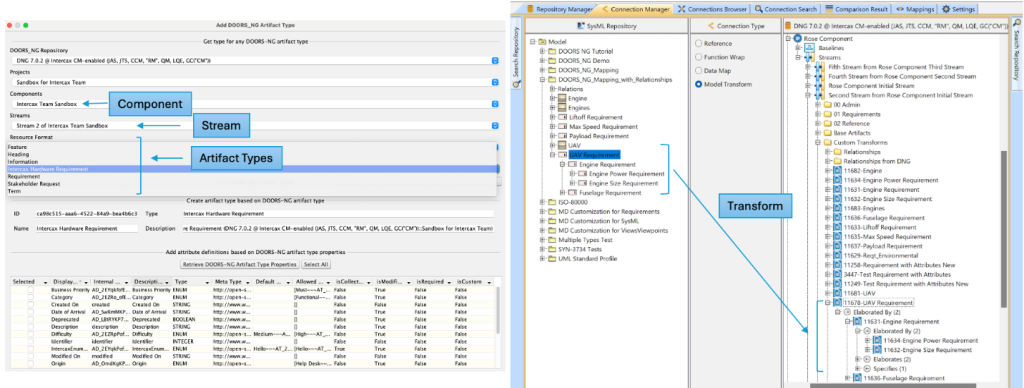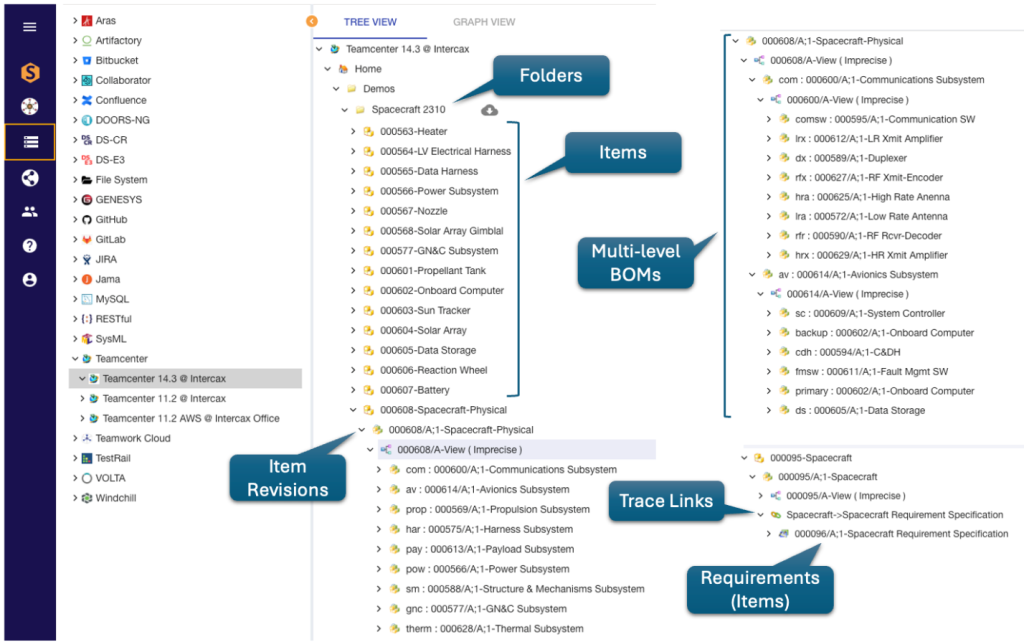Intercax has always emphasized offering a practical solution to digital engineering. Syndeia was introduced commercially in 2014, but even the earliest integrations are in a continual state of revision as vendor updates and customers feedback are incorporated.
In this blog post, many of the significant integration enhancements in Syndeia 3.6 are summarized. These include
- Teamcenter (Siemens), which can now be accessed from the Syndeia Web Browser and through the Syndeia Cloud REST API,
- DOORS NG (IBM), where users have greater control over custom mappings into specific Streams and Baselines, and
- Increased options for Syndeia authentication into Aras, Windchill and VOLTA.
These solutions addressed real-world problems in implementing Syndeia in customer development environments and are now incorporated into the standard Syndeia product offering for all users. They represent the value of a “battle-tested” digital thread platform.

DOORS NG
Syndeia 3.6 brings significant improvements to the DOORS-NG integration, backed by the Syndeia Cloud API. Users can create artifact types for Components of DOORS-NG projects and use them in defining custom mappings. Model transformation and compare and sync operations based on custom mappings are better supported for non-default streams of project components. (Figure 1).

Teamcenter
Teamcenter was one of the earliest integrations available with Syndeia, but only through the SysML client plugins. With Syndeia 3.6, the Teamcenter integration is now live on Syndeia Cloud, available through its REST API to all clients. Users can connect to multiple Teamcenter repositories from the Web Dashboard, browse Teamcenter content such as parts, requirements, and other items, and view item revisions, multi-level BOM structures (Precise and Imprecise), and cross-cutting trace links between Teamcenter items. This capability is available in both the Tree View and the Graph View as shown in Figure 2. Users can also build digital thread relations with Teamcenter artifacts on the Web Dashboard and connect them to artifacts in any repository. Digital Thread Explorer will show both intra-model (within) and inter-model (across) relations from/to Teamcenter artifacts. Model transformation capabilities between SysML and Teamcenter continue to be available via the Syndeia SysML clients. In addition, Teamcenter Active Workspace is now supported.
Aras Innovator
Syndeia 3.6 adds an improvement to OAuth2 authentication with Aras Innovator repositories. Users now have the option to input passwords which are converted to MD5 hash by default (per the Aras REST API), or directly provide a hashed input (e.g. SHA-256) if the Aras Innovator server is configured to accept the same. Syndeia also enables users to add repositories that are configured with a non-default web aliases, e.g. provide the full Aras Innovator server URL with a custom web alias.
Windchill
Syndeia 3.6 users will be able to connect to Windchill via OAuth2 authentication protocol. Syndeia will redirect them to the Ping Federate IdP for sign-in, and once approved, users will be able to browse Windchill repositories in the Web Dashboard.
VOLTA
Syndeia 3.6 introduces API Key-based authentication for VOLTA repositories. In addition to credentials (username/password), Syndeia users can also authenticate with VOLTA repositories using API keys available for their accounts from the VOLTA web application.
The final blog post in this series, Part 10, will cover some of the changes in the Syndeia REST API endpoints and Syndeia on-line training materials, with a brief look at some plans for future releases.
Other parts in this series:
- Syndeia 3.6 Release, Part 9: Integration Enhancements (This Part)
